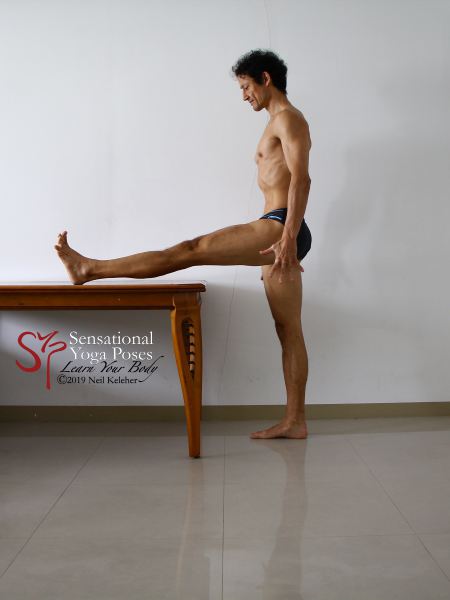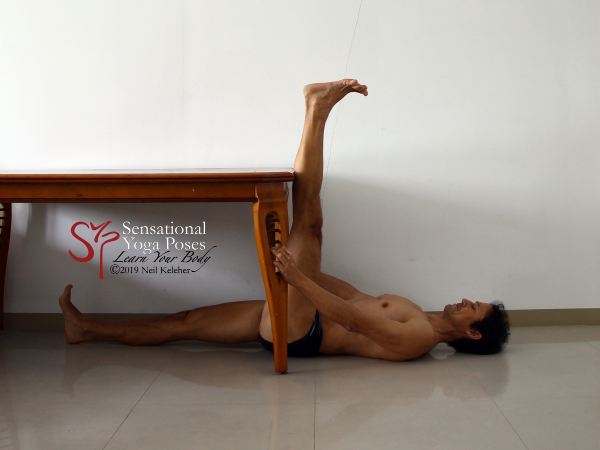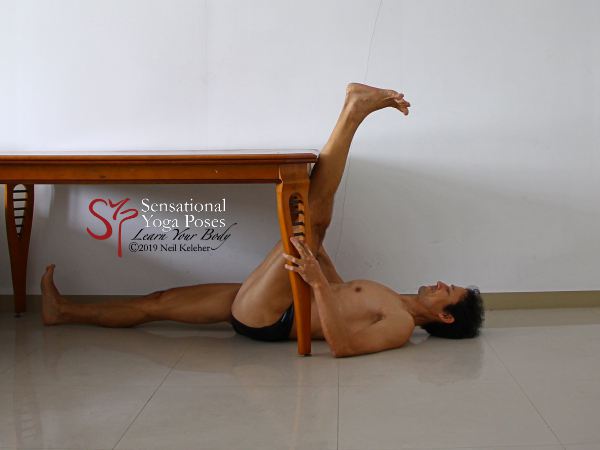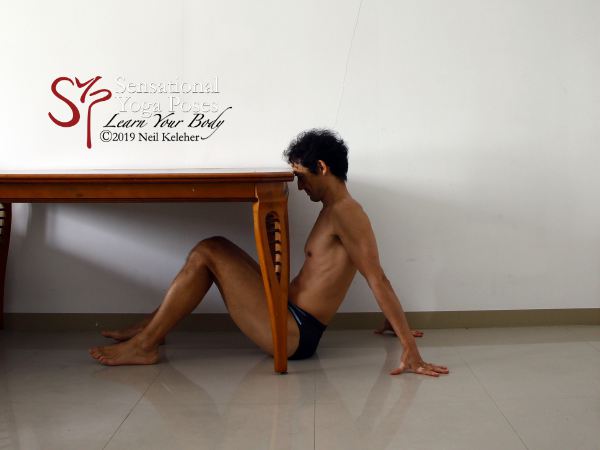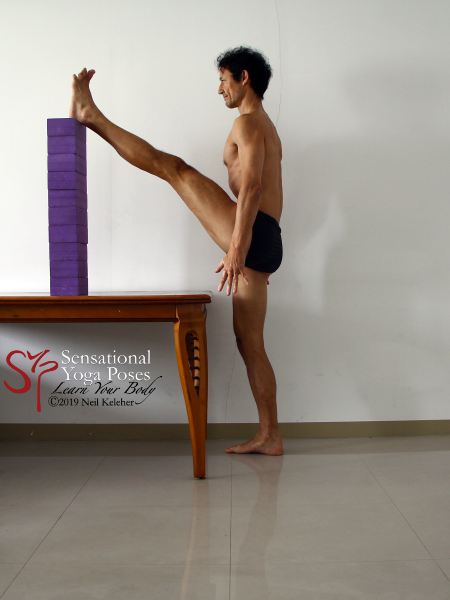Simple Postures for Stretching Your Hamstrings
Using props in different ways to stretch your hamstrings
I was asked for an easier way to stretch the hamstrings. As an example, in virasana it's pretty easy to chip away at hip flexor tightness. (In virasana you knee with your butt between your heels. Then from there you lie back and it's pretty easy to control the stretch using yoga blocks or a wall.) Is there a similar pose for stretching the hamstrings?
I had to think a bit on this since my usual answer would tend towards something about muscle control. And I've been working on various programs to help with muscle control and thus hamstring flexibility. Was there a way that could help while only partially relying on muscle control?
A Really Easy Posture for Stretching Your Hamstrings
One option for easily stretching the hamstrings is to lie on your back close to a wall with your feet resting on the wall.
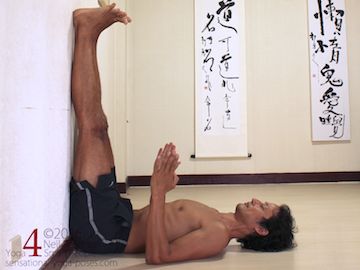
Note this picture was taken from a series on prepping for shoulder stand using a wall, hence the pressing of the elbows into the floor. However, do note that my legs are active.
The closer you get your butt to the wall the more you stretch your hamstrings.
So this is really good for people who can't bend to 90 degrees at the hips. It's also a very nice way to relax while doing "yoga". But you don't have to relax while in this pose.
What can you do while your legs are up against a wall?
Turning This Easy Posture into a Resisted Active Stretch
If you wanted to make it an active hamstring stretch one thing you can do is press your heel (one leg or both) into the wall without allowing your hips or upper body to move.
The more you press your heel, the stronger the activation should be at the back of the leg. (You can do this one leg at a time or using both legs at the same time.) Try adjusting the rotation of your thigh (or thighs) to vary the sensation.
Now rather than just holding this action you can press the wall and then relax repeatedly, with a slow and smooth rhythm. If you do it slowly and smoothly while focusing on the changes in sensation you can turn this into a meditative action similiar in nature to many breathing exercises. The only difference is that here the muscles you are focusing on feeling aren't the muscles that you normally breathe with.
Muscle Assisted Active Stretching
Another option for active stretching is to try pulling your leg or legs away from the wall while keeping your knees straight. You'll be using your hip flexors and you may find it helps to make your spine (particularly your lumbar spine and sacrum) feel long.
You may find that your abs engage as a result. You could also focus on making your foot and ankle feel strong.
In either case, try to keep your upper body still as you work at peeling your leg(s) off of the wall.
Note, if you get back pain doing this then one way to work around that is to try to stabilize your hip joint and/or your SI joints, lumbar spine and the junction between your lumbar spine and thoracic spine (the bottom of your ribcage).
Bending Your Hips Beyond 90 Degrees
Now, what if you can bend your hips forwards beyond 90 degrees? The wall isn't going to be very useful unless you want to reach up and grab one or both feet (you could use a belt or strap).
An option is to place a table against a wall so that it doesn't move, then lie with just your legs under the table. Lift one leg and place it against the edge of the table.
The further you move under the table the more you stretch the hamstring of the lifted leg.
Note that in both pictures above I'm grabbing onto the table legs so so that the table doesn't move and also to help anchor my upper body.
One thing that I'm trying to do in the pictures above is to make both of my legs active. This means that both hips are stable and even though I'm lying on the ground, I'm trying to engage my midsection by making my spine feel long (particularly the lumbar spine and sacrum).
Note, after doing the other leg, do be cautious when getting up. It can be easy to bump your head on the table as you get up.
Resisting the Stretch
An alternative to just making both legs active or stable is to try to resist the stretch by pushing your leg against the edge of the table. Then relax and repeat (slowly and smoothly). After a few repetitions you may find that you can move further under the table and so deepen the stretch to your hamstring.
A Standing Hamstring Stretch
Now another option for stretching the hamstrings is to stand on one leg and rest the other leg, the leg you are stretching, on the table.
Here it can be even more important to make sure that your other leg, the leg not being stretched, is stable.
On some days I like to focus on foot and ankle stability. On other days I focus on the hips. On other days I focus on both. (And there are other ways to play with stability also.)
As with the supine (lying on your back) version, make your spine long.
In this pose you can work at pressing your heel down against the top of the table without allowing your body to move.
Relax and repeat a few times.
Note that you can bend forwards in this position to work at stretching your hamstrings further. Check out the hamstring stretching yoga poses page for more details on different ways to activate leg muscles to make hamstring stretching easier.
A Standing Hamstring Stretch, Jenga Style
If you have yoga blocks, a lot of them, you can increase the stretch by placing yoga blocks on the table and placing your heel on top of them. You can then gradually increase the stretch by increasing the height of your yoga block tower.
A step ladder could also be used in a similar way.
Note that with yoga blocks the challenge can be placing your leg on them without knocking the blocks over. You can think of this as a version of jenga.
Also note, I'm using yoga blocks for these photos because I'm being silly. At the gym there are pieces of equipment that I can use to easily prop my leg up at different heights. So use something that is stable.
Revisiting the Main Points
As mentioned, when doing this type of supported hamstring stretch I'd suggest that it is very important to make the standing leg stable. That can include stabilizing the foot and ankle, the knee and/or the hip. From there you can again use resisted active stretching by pressing your leg down against the table or whatever it is resting on.
Note, here again, focus on feeling the activation as you do it. You should notice tension in your hamstrings and glutes as you press down against the table.
As you get comfortable at whatever hight you are using, you can then elevate your leg higher.
Note, as you get higher, you may have to have something to hold on to to help stay balanced.
Also, as you start getting higher, make sure that you can easily place your leg in position and easily take it out of position without messing up your knee.
So find a means of gradually increasing the height.
And, make sure that whatever you are using won't tip over. That can require a little bit of skill on your part.
Published: 2019 04 02
Updated: 2020 08 03
